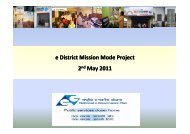State Mission Mode Project e-district - Department of Electronics and ...
State Mission Mode Project e-district - Department of Electronics and ...
State Mission Mode Project e-district - Department of Electronics and ...
Create successful ePaper yourself
Turn your PDF publications into a flip-book with our unique Google optimized e-Paper software.
Study Report on Assessment <strong>of</strong> the <strong>Mode</strong>l e-<strong>district</strong>s<br />
4. The s<strong>of</strong>tware for Jan Sewa Kendra has been developed by the private company, M/s<br />
Microtech Systems. It provides for easy retrieval <strong>of</strong> various forms from the website, online<br />
tracking <strong>of</strong> applications by the citizen, online grievance registration, online monitoring by<br />
the Collectorate Officials etc. The s<strong>of</strong>tware is bilingual with all the forms <strong>and</strong> fields in<br />
Gujarati <strong>and</strong> option for certain fields like Name, Father’s name to be filled in English.<br />
5. Connectivity – Gujarat is one <strong>of</strong> the first states in establishing SWAN in as early as 2001.<br />
GSWAN Connectivity is established up to Taluka level, which has enabled NIC to take the<br />
services <strong>of</strong> Jan Sewa Kendra up to Taluka level. In the Ahmedabad <strong>district</strong> Collectorate, a<br />
LAN with approx 80 nodes has been established <strong>and</strong> is connected to GSWAN. This enables<br />
the data aggregation <strong>and</strong> data exchange between Talukas <strong>and</strong> <strong>district</strong> <strong>of</strong>fice.<br />
Apart from the Jan Sewa Kendra, Ahmedabad <strong>district</strong> has implemented following e-<br />
governance initiatives from Phase II <strong>and</strong> Phase III so far:<br />
6. Non Agriculture Use Permission Cases – Backend Process – Ahmedabad <strong>district</strong> is one <strong>of</strong><br />
the pioneering <strong>district</strong> in terms <strong>of</strong> achieving 100% computerization <strong>of</strong> l<strong>and</strong> records as well<br />
as mutation records <strong>of</strong> the same being updated on a regular basis. It further has<br />
undertaken digitization <strong>of</strong> sub registrar’s data till 1994. It has online Record <strong>of</strong> Rights for<br />
the l<strong>and</strong> at all Talukas which include 7X12 (Area), Form 8 (Details <strong>of</strong> owner) <strong>and</strong> Form 6<br />
(Transactions on the l<strong>and</strong>). Ahmedabad being the largest industrial city <strong>of</strong> Gujarat, it has a<br />
large dem<strong>and</strong> for conversion <strong>of</strong> agriculture l<strong>and</strong> to commercial <strong>and</strong> residential. The old<br />
system involved three departments’ clearances to grant NA permission, it used to take 2 to<br />
3 years for the permission to come in, <strong>and</strong> there were a large number <strong>of</strong> applications<br />
pending. Now, a system <strong>of</strong> parallel processing has been established at NA section, where<br />
five copies <strong>of</strong> the application are taken from the applicant, <strong>and</strong> it is simultaneously send to<br />
the three departments for their NOC. Talati’s, Mamlatdar’s certificates for Record <strong>of</strong> Rights<br />
are also asked for, but these can be accessed online also to take a decision, if need be<br />
there. These initiatives have helped the <strong>district</strong> <strong>of</strong>fice to reduce the processing time to 3<br />
to 4 months <strong>and</strong> it has also resulted in the increased revenue for the state.<br />
7. Inward Registry <strong>of</strong> Ahmedabad Collectorate is fully computerized. All the incoming dak at<br />
the Collectorate is entered in a web based s<strong>of</strong>tware capturing key information <strong>of</strong> the<br />
applicant, subject involved <strong>and</strong> the branch responsible for taking action on the application.<br />
Each dak is given a unique Tapal number <strong>and</strong> is traceable by this Tapal number. The<br />
average number <strong>of</strong> dak received daily is about 350 <strong>and</strong> there are three operators to process<br />
these daks, The dak is then sent to the respective branches where it is assigned the<br />
appropriate desk by the concerned staff. After processing the dak, the staff then updates<br />
the status in the s<strong>of</strong>tware. The employees can also entered the suo moto dak generated by<br />
them for processing <strong>of</strong> received applications. To assess the work done by an employee,<br />
Online Worksheet can taken by each branch. This s<strong>of</strong>tware enables monitoring <strong>of</strong> workload<br />
72




